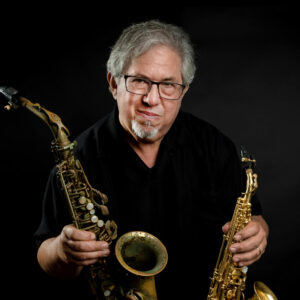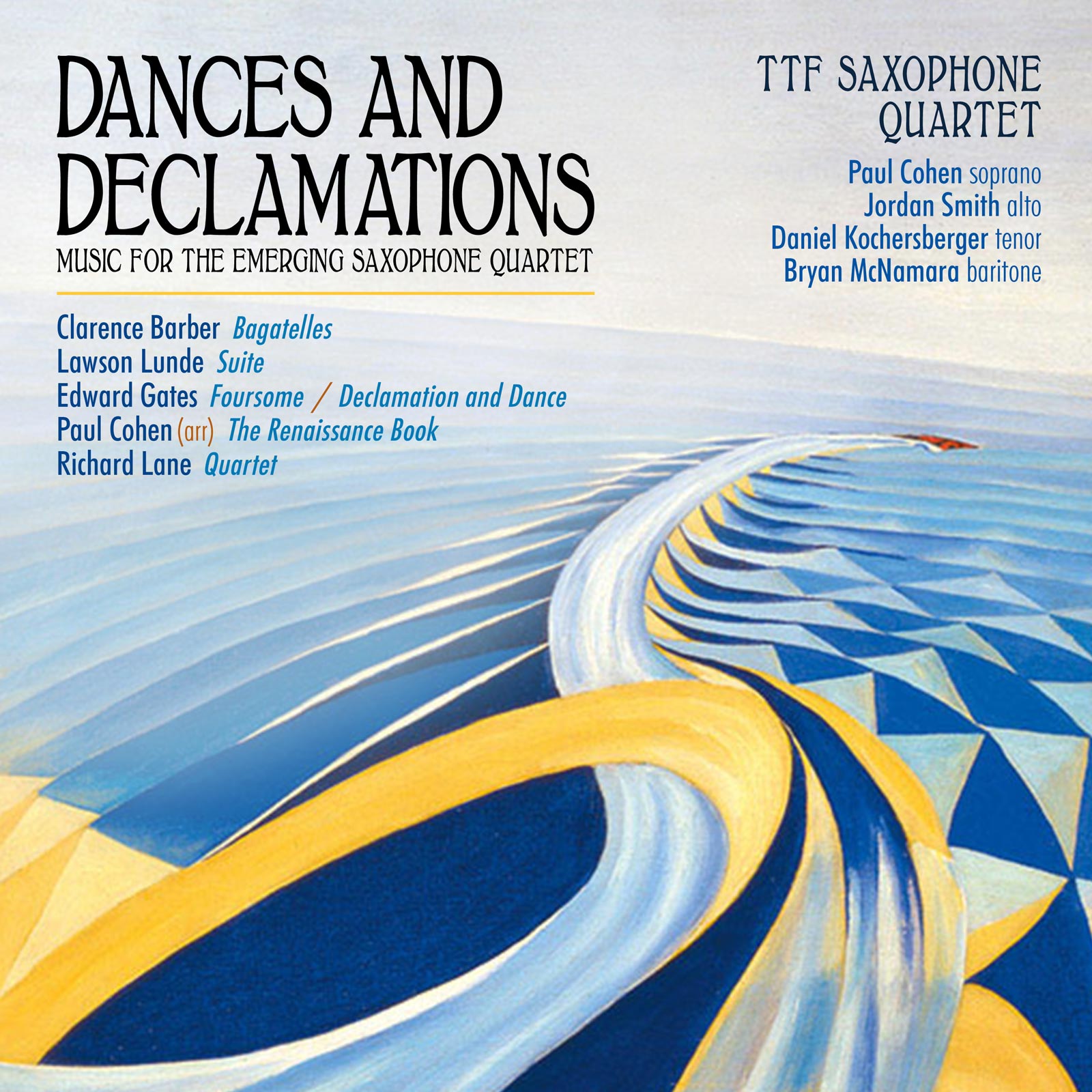Dances and Declamations
Clarence Barber composer
Lawson Lunde composer
Edward Gates composer
Paul Cohen arranger
Richard Lane composer
TTF Saxophone Quartet
Paul Cohen soprano
Jordan Smith alto
Daniel Kochersberger tenor
Bryan McNamara baritone
Contemporary music is often difficult to access, both for audiences and performing musicians, and doubly so if it involves unorthodox musical setups. Paul Cohen, leader of the TTF Saxophone Quartet, is here to challenge this conundrum. DANCES AND DECLAMATIONS compiles a treasure trove of saxophone quartets that are a pleasure to play — and to experience.
This eclectic collection includes modern, minimalist constructions, Brucknerian soundscapes, waltzes, fugues, and not least Cohen’s own arrangements of Renaissance dances. Each of the pieces on DANCES AND DECLAMATIONS are imbued with genuine cheer, liveliness, and appeal. It’s music that speaks to the mind, yes, but even more importantly, puts a spring in your step.
Listen
Stream/Buy
Choose your platform
Track Listing & Credits
| # | Title | Composer | Performer | |
|---|---|---|---|---|
| 01 | Bagatelles: I. Allegro | Clarence Barber | TTF Saxophone Quartet | Paul Cohen, soprano; Jordan Smith, alto; Daniel Kochersberger, tenor; Bryan McNamara, baritone | 3:54 |
| 02 | Bagatelles: II. Allegro giocoso | Clarence Barber | TTF Saxophone Quartet | Paul Cohen, soprano; Jordan Smith, alto; Daniel Kochersberger, tenor; Bryan McNamara, baritone | 2:46 |
| 03 | Suite: I. Prelude | Lawson Lunde | TTF Saxophone Quartet | Paul Cohen, soprano; Jordan Smith, alto; Daniel Kochersberger, tenor; Bryan McNamara, baritone | 1:25 |
| 04 | Suite: II. Five Tones | Lawson Lunde | TTF Saxophone Quartet | Paul Cohen, soprano; Jordan Smith, alto; Daniel Kochersberger, tenor; Bryan McNamara, baritone | 1:04 |
| 05 | Suite: III. Eclogue | Lawson Lunde | TTF Saxophone Quartet | Paul Cohen, soprano; Jordan Smith, alto; Daniel Kochersberger, tenor; Bryan McNamara, baritone | 2:16 |
| 06 | Suite: IV. Interlude | Lawson Lunde | TTF Saxophone Quartet | Paul Cohen, soprano; Jordan Smith, alto; Daniel Kochersberger, tenor; Bryan McNamara, baritone | 0:37 |
| 07 | Suite: V. Finale | Lawson Lunde | TTF Saxophone Quartet | Paul Cohen, soprano; Jordan Smith, alto; Daniel Kochersberger, tenor; Bryan McNamara, baritone | 1:52 |
| 08 | Foursome: I. Four-Square Ostinato | Edward Everett Gates | TTF Saxophone Quartet | Paul Cohen, soprano; Jordan Smith, alto; Daniel Kochersberger, tenor; Bryan McNamara, baritone | 1:40 |
| 09 | Foursome: II. Four-in-Three | Edward Everett Gates | TTF Saxophone Quartet | Paul Cohen, soprano; Jordan Smith, alto; Daniel Kochersberger, tenor; Bryan McNamara, baritone | 1:23 |
| 10 | Foursome: III. Two-by-Two Canon | Edward Everett Gates | TTF Saxophone Quartet | Paul Cohen, soprano; Jordan Smith, alto; Daniel Kochersberger, tenor; Bryan McNamara, baritone | 0:52 |
| 11 | Foursome: IV. Four-Ward March | Edward Everett Gates | TTF Saxophone Quartet | Paul Cohen, soprano; Jordan Smith, alto; Daniel Kochersberger, tenor; Bryan McNamara, baritone | 1:15 |
| 12 | The Renaissance Book: I. Three Dances | arr. Paul Cohen | TTF Saxophone Quartet | Paul Cohen, soprano; Jordan Smith, alto; Daniel Kochersberger, tenor; Bryan McNamara, baritone | 2:20 |
| 13 | The Renaissance Book: II. Ah Robin | arr. Paul Cohen | TTF Saxophone Quartet | Paul Cohen, soprano; Jordan Smith, alto; Daniel Kochersberger, tenor; Bryan McNamara, baritone | 2:42 |
| 14 | The Renaissance Book: III. Downberry Down | arr. Paul Cohen | TTF Saxophone Quartet | Paul Cohen, soprano; Jordan Smith, alto; Daniel Kochersberger, tenor; Bryan McNamara, baritone | 2:03 |
| 15 | The Renaissance Book: IV. Blow thy Horn, Hunter | arr. Paul Cohen | TTF Saxophone Quartet | Paul Cohen, soprano; Jordan Smith, alto; Daniel Kochersberger, tenor; Bryan McNamara, baritone | 0:47 |
| 16 | The Renaissance Book: V. Where Be Ye, My Love | arr. Paul Cohen | TTF Saxophone Quartet | Paul Cohen, soprano; Jordan Smith, alto; Daniel Kochersberger, tenor; Bryan McNamara, baritone | 1:44 |
| 17 | The Renaissance Book: VI. Pastime with Good Company | arr. Paul Cohen | TTF Saxophone Quartet | Paul Cohen, soprano; Jordan Smith, alto; Daniel Kochersberger, tenor; Bryan McNamara, baritone | 1:04 |
| 18 | Quartet (for Saxophones): I. Prelude | Richard Lane | TTF Saxophone Quartet | Paul Cohen, soprano; Jordan Smith, alto; Daniel Kochersberger, tenor; Bryan McNamara, baritone | 1:24 |
| 19 | Quartet (for Saxophones): II. Waltz | Richard Lane | TTF Saxophone Quartet | Paul Cohen, soprano; Jordan Smith, alto; Daniel Kochersberger, tenor; Bryan McNamara, baritone | 1:33 |
| 20 | Quartet (for Saxophones): III. Fugue-like | Richard Lane | TTF Saxophone Quartet | Paul Cohen, soprano; Jordan Smith, alto; Daniel Kochersberger, tenor; Bryan McNamara, baritone | 1:46 |
| 21 | Quartet (for Saxophones): IV. Lament | Richard Lane | TTF Saxophone Quartet | Paul Cohen, soprano; Jordan Smith, alto; Daniel Kochersberger, tenor; Bryan McNamara, baritone | 2:04 |
| 22 | Quartet (for Saxophones): V. Finale | Richard Lane | TTF Saxophone Quartet | Paul Cohen, soprano; Jordan Smith, alto; Daniel Kochersberger, tenor; Bryan McNamara, baritone | 1:26 |
| 23 | Declamation and Dance | Edward Everett Gates | TTF Saxophone Quartet | Paul Cohen, soprano; Jordan Smith, alto; Daniel Kochersberger, tenor; Bryan McNamara, baritone | 3:39 |
Tracks 1, 2, 18-23
Recorded July 2022 at Sound Imagination Studio in Clark NJ
Recording Engineer Ed Kessel
Tracks 3-17
Recorded August 2022 & July 2023 at Trading 8s Studio in Maywood NJ
Recording Engineer Chris Sulit
Mastering Melanie Montgomery
Executive Producer Bob Lord
VP of A&R Brandon MacNeil
A&R Jeff LeRoy
VP of Production Jan Košulič
Audio Director Lucas Paquette
VP, Design & Marketing Brett Picknell
Art Director Ryan Harrison
Design Morgan Hauber
Publicity Chelsea Kornago
Artist Information

Paul Cohen
Paul Cohen is a sought-after saxophonist for orchestral and chamber concerts and solo recitals. He has appeared as soloist with the San Francisco Symphony, Richmond Symphony, New Jersey Symphony, Charleston Symphony, and the Philharmonia Virtuosi. His many solo orchestra performances include works by Debussy, Creston, Ibert, Glazunov, Martin, Loeffler, Husa, Dahl, Still, Villa-Lobos, Tomasi, and Cowell. He has also performed with a broad range of orchestras, including the New York Philharmonic, Metropolitan Opera (NYC), American Symphony Orchestra, Cleveland Orchestra, Santa Fe Opera, New Jersey Symphony, Oregon Symphony, San Diego Symphony, Long Island Philharmonic, Group for Contemporary Music, Greenwich Symphony, and New York Solisti.
Jordan Smith
With reviews praising his “liquid tone,” saxophonist Jordan P. Smith has concertized throughout the United States and Europe as soloist, conductor, and chamber musician. As an orchestral member, he has performed with the New World Symphony, Chamber Orchestra of Philadelphia, Monmouth Symphony, Bravura Philharmonic, and the Sifodec Orchestra. He has worked with conductors such as Michael Tilson Thomas, Robert Spano, H. Robert Reynolds, and Eugene Corporon. As a strong proponent of new music, Smith has premiered over 30 works by composers from around the world.
Daniel Kochersberger
Daniel Kochersberger, originally of Canandaigua NY, is a saxophonist actively participating in the NYC contemporary music scene. Kochersberger is a founding member of the Manhattan Saxophone Quartet, the Epoch Saxophone Duo, and is the saxophonist for the New York-based ensemble Contemporaneous (www.contemporaneous.org). He has performed and recorded with artists such as David Byrne, Rinde Eckert, and Jherek Bischoff in new music venues including Times Square, Lincoln Center, (le) poisson rouge, the Flea Theater, NYU’s Skirball Center, National Sawdust, and Roulette.
Bryan McNamara
Bryan McNamara began his music-making career at age 6 in his upstate New York church handbell choir. The saxophone came next at age 10. 22 years later, he is a versatile and happily busy musician, educator, and arts administrator. Macnamara performs with Singularity, the saxophone quartet he co-founded in 2013. Pulitzer Prize-winning composer Charles Wuorinen wrote that Singularity “brought a wonderful life and spirit” to his work in their 2015 Carnegie Hall debut.
Notes
The 21st century saxophone quartet enjoys an abundance of brilliant, complex, and demanding music requiring the highest level of technical preparation and musical awareness. Younger and emerging quartets often struggle with this music, resulting in performances focused on individual part preparation and ensemble coordination, but lacking musical understanding. While players are left with the pride of technical accomplishment, they miss the deeper musical experience.
Emerging saxophone quartets need a body of excellent works that will allow nuanced technical development combined with artistic fulfillment. It is part of their growth to evolve into musicians and not just technicians; to embrace the totality of a musically complete performance.
The compositions on this album are especially suited to this goal. They work well in any performance setting but are less technical, with musical ideas more quickly and easily grasped. The satisfaction and awareness of a complete musical experience are as important as learning the complexities of more technical works. It is just as important to the player’s performing aesthetic as any technical accomplishment.
Enjoy these wonderful saxophone quartets!

